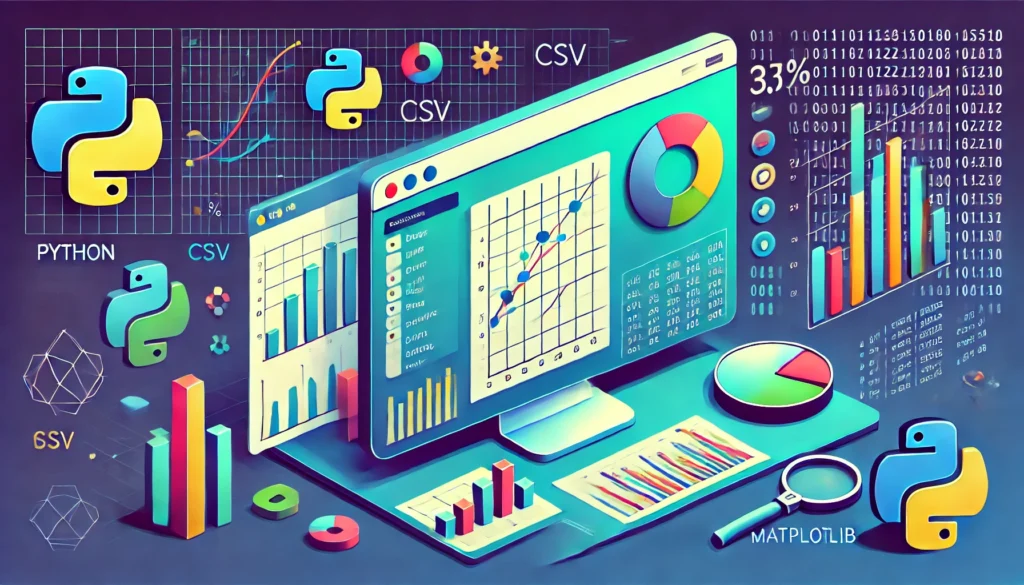Project: Sales Data Analysis and Visualization using Python, Matplotlib, and CSV

Are you a CBSE Class 12th IP student looking for an interesting project that blends data analysis, visualization, and programming? In this blog, we’ll walk you through a comprehensive project where you’ll learn how to analyze and visualize sales data using Python, with CSV as the data source and Matplotlib for creating graphs and charts.
By the end of this project, you’ll be able to read data from a CSV file, process the data, and display beautiful visualizations using charts like bar graphs, line plots, and pie charts!
Amazon Sale
Project Overview:
Title: Sales Data Analysis and Visualization
This project will allow you to:
- Handle CSV files in Python.
- Perform data analysis (total sales, monthly comparisons, etc.).
- Create visual representations using Matplotlib for better data insights.
Objective:
The primary goal is to analyze monthly sales data, calculate trends, and present insights in the form of interactive visualizations using Python’s Matplotlib library.
Technologies Used:
- Python: For reading and analyzing data.
- CSV (Comma Separated Values): For storing and reading data.
- Matplotlib: To visualize the data using various chart types.
Step-by-Step Guide to the Project:
1. Understanding CSV Data Handling in Python
CSV is a simple format for storing tabular data, such as sales records. Our CSV file (sales_data.csv) will store sales information with columns like:
- Month: The month of sales (e.g., January, February).
- Product: The product name (e.g., Mobile, Laptop).
- Quantity: Quantity of the product sold.
- Sales: Total sales value for the product.
Sample CSV Data:
Month,Product,Quantity,Sales
January,Mobile,50,25000
January,Laptop,30,150000
February,Mobile,45,22500
February,Laptop,20,100000
...Using Python’s csv module, we can read this file and process the data to calculate monthly totals, identify trends, and more.
2. Reading and Processing the CSV Data
Start by reading data from the CSV file and storing it in a format that can be analyzed. Below is the Python function to read the CSV file:
import csv
def read_sales_data(filename):
data = []
with open(filename, 'r') as file:
reader = csv.DictReader(file)
for row in reader:
data.append(row)
return dataThis function reads the data from the CSV file and returns it as a list of dictionaries for easy processing.
3. Analyzing the Sales Data
Once the data is loaded, we can analyze it to find out the monthly sales totals. We create a function to sum up sales for each month.
def calculate_monthly_sales(data):
sales_per_month = {}
for row in data:
month = row['Month']
sales = float(row['Sales'])
if month in sales_per_month:
sales_per_month[month] += sales
else:
sales_per_month[month] = sales
return sales_per_monthThis function calculates the total sales for each month and returns the result in a dictionary format.
4. Data Visualization Using Matplotlib
Data is much easier to understand when visualized. We’ll use Matplotlib to create various charts for sales data.
- Bar Chart: To compare sales across different months.
- Line Chart: To see trends over time.
- Pie Chart: To visualize sales distribution across different product categories.
Example of a Bar Graph:
import matplotlib.pyplot as plt
def plot_sales_data(sales_per_month):
months = list(sales_per_month.keys())
sales = list(sales_per_month.values())
plt.figure(figsize=(10, 5))
plt.bar(months, sales, color='skyblue')
plt.xlabel('Month')
plt.ylabel('Sales (in INR)')
plt.title('Monthly Sales Data')
plt.show()This simple bar chart compares monthly sales, giving you a quick understanding of which months had the highest and lowest sales.
5. Enhancing the Project
Additional Functionalities:
- Add New Sales Data: Create a function to add new sales data to the CSV file.
def add_sales_data(filename, month, product, quantity, sales):
with open(filename, 'a', newline='') as file:
writer = csv.writer(file)
writer.writerow([month, product, quantity, sales])- Search Sales by Month: Retrieve and display all sales records for a specific month.
def search_sales_by_month(data, month):
return [row for row in data if row['Month'] == month]These features can make the project more interactive and practical.
6. Project Conclusion
By the end of this project, you will have learned how to:
- Work with CSV files in Python.
- Analyze sales data.
- Visualize data using different types of charts (bar, line, pie) with Matplotlib.
This project offers a great learning opportunity for students preparing for their CBSE Class 12th IP exams. It will help you understand the importance of data analysis and visualization, skills that are highly valued in today’s data-driven world.
What’s Next?
You can extend this project by adding more analysis like calculating average sales, identifying trends, or even connecting to a database for more robust data handling.
Final Thoughts:
This project serves as an excellent foundation for understanding how real-world data is managed and visualized. From CSV handling to powerful data visualization techniques using Matplotlib, you’ll have hands-on experience with key Python skills that are not only useful for your exams but also valuable in many fields, including business and data science.
Happy coding, and good luck with your CBSE Class 12th IP project!
Keywords: Python, CSV, Matplotlib, Data Analysis, Data Visualization, CBSE Class 12th IP, Sales Analysis, Project






